The Lancia Delta
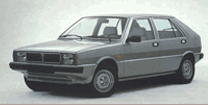
The Lancia
δ
(the name Delta was written by the Greek letter) is presented to the public during the Frankfurt Motor Show in 1979.
It seems immediately a balanced and pleasant car, that amalgam the elegance of chrome trim and some details and modernity of the great synthetic resin bumper painted in body color.
Initially, the engine range includes two units, both petrol. The first, is a 1301 cm3, able to express a power of 75 hp at 5800 rpm; This engine is offered with either four-speed gearbox, both with five-speed gearbox, with a fifth gear, suitable for use suburban and highway.
The second engine, offered only with a five-speed gearbox, ia s 1498 cm3, capable of delivering 85 hp at 5600 rpm.
In 1980, thanks to its success in the audience, it was awarded as "Car of the Year".
In 1982, the three versions already existing (1300 4-speed, 5-speed 1300, 1500), are accompanied by the LX version.
In 1983, the first Delta has a cosmetic upgrade recognizable among other things for the new bumpers and a new interior.
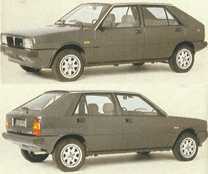
The engine of 1498 cm3 is dedicated to a version with automatic transmission and a new DOHC of 1585 cm3 able to develop a power of 105 hp comes.
Delta GT is born, equipped with four wheel disc brakes with brake assist, which reaches a speed 'of 180 km/h.
Compared to the basic version, the GT features standard instrumentation with tachometer and has the chance to install the air conditioner.
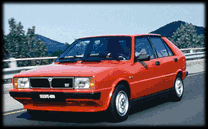
Also in 1983 it was presented the first sports version of the Delta: the Delta HF.
Externally very similar to the GT,
has the engine of 1585 cm3 powered carburetor,
to which is added a Garrett T3 turbocharger with air/air intercooler and waste-gate valve.
The 130 hp turbo engine put Delta HF performance at the top of the class,
together with a style that has no competitors at all.

Meanwhile, at the Turin Motor Show in 1982, the first 4x4 version appears:
the "Lancia Delta Turbo 4x4".
It is a "study-proposal", which uses the 1585 turbo engine of the future HF version
and a sophisticated all-wheel drive system with three differentials.
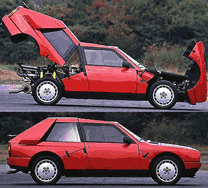
Next in 1985 the Delta S4, "S" as Supercharged, "4" as a four-wheel drive. Designed specifically as a Gr.B car, with a cromomolibdeno tubes steel frame, the Delta S4 is a special chapter in the Delta family. First four-wheel drive Lancia, is also the first car in the world with an innovative charging system of the engine: turbocharger exhaust plus supercharger. Approved for competition on 1985 November the 1st, less than a month after, the Delta S4 reaches the top two positions of the RAC Rally with Toivonen-Wilson and Alen-Kivimaki.
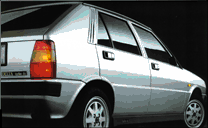
In 1986, the Lancia Delta is renewed again. With two new versions, Delta HF4WD and Turbo DS, and the S4 street version the range now is complete. New bumper design and a few tweaks to the design and to the interior, with a redesigned and more functional dashboard, together with the extended use of electronics, mark the new versions.
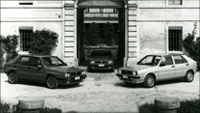
In 1990, the Delta range, which in the meantime in 1987 include the catalyzed versions, follow to the new demands of the market, acquiring some of the content available so far only as an option, such as central locking, front electric windows and front fog lamps. Versions are now: 4 engines 1600 cm3, GTie, 1600 GTie Europe, HF Turbo, Turbo HF Europe, 1 1900 cm3 turboDS and the 2000 cm3, the HF integrale 16v.
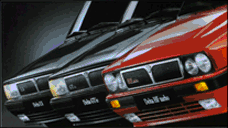
In 1991, new versions, with new body and engines. The Delta range now consists of the LX version with 1500 cm3 engine, the 1600 GT ie, HF Turbo with 1600 cm3 engine, besides the HF integrale (the EVO). The 1500 LX is the only carbureted, all the others are equipped with injection and catalytic version. The HF Turbo for the first time adopts the round headlights.
In 1992, with the stop of Lancia Chivasso Plant, end the production of the Lancia Delta. However, are to be presented the last two versions, the 1600 GT series and the final 1600 HF Turbo.



